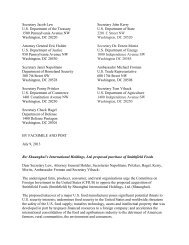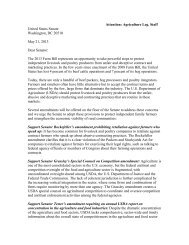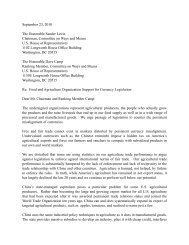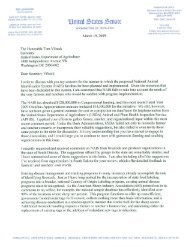Exhibit 8, 100416 Brazil FMD Risk Evaluation - R-Calf
Exhibit 8, 100416 Brazil FMD Risk Evaluation - R-Calf
Exhibit 8, 100416 Brazil FMD Risk Evaluation - R-Calf
You also want an ePaper? Increase the reach of your titles
YUMPU automatically turns print PDFs into web optimized ePapers that Google loves.
<strong>Brazil</strong>ian law prohibits all transport of animal and plant products from anywhere in the world<br />
without proper permits. Airline passengers are checked for animal and plant products. The type of<br />
inspection depends on the origin of the flight. Shipments arriving by sea are also checked for<br />
animals and animal products, while ship passengers receive random checks for the presence of<br />
animals and animal products. Prohibited items are confiscated, stored, and transported by the<br />
contract company to the incinerator under MAPA supervision. Customs officials X-ray a percentage<br />
of arriving luggage and confiscate prohibited products. They increase the percentage of luggage<br />
undergoing X-ray for flights arriving from high-risk areas such as Spain and Portugal, which have<br />
small artisan farms with no government oversight, or countries with outbreaks. In addition,<br />
passengers from high-risk countries must walk across a disinfectant mat. One hundred percent of<br />
luggage from countries having an <strong>FMD</strong> outbreak goes through X-ray inspection.<br />
Inspection stations<br />
MAPA controls products imported from other countries at the authorized entry points. Prior to<br />
importation, the importer must procure authorization from MAPA. MAPA evaluates the sanitary<br />
conditions of the exporting country as well as the exporting facility. If MAPA authorizes the<br />
importation, the entry point into <strong>Brazil</strong> will be specified on the authorization and MAPA’s<br />
International Agriculture and Livestock Surveillance Service at the point of entry will receive a copy<br />
of the authorization with all the specific sanitary requirements listed. The products must receive<br />
inspection and authorization from the official veterinarian at the point of entry to be released into<br />
Santa Catarina [4].<br />
Permanent inspection stations are located at strategic points along the border of Santa Catarina.<br />
There are 67 permanent inspection stations for import of plants, animals and products into Santa<br />
Catarina (see Figure 8). These stations are staffed by 429 professionals from the official veterinary<br />
services, who work in shifts to provide 24-hour coverage. Operations at each post are coordinated<br />
by an official veterinarian and include police support. The inspection posts have communications<br />
equipment, computers, vehicles, equipment for cleaning and disinfection, and an area for<br />
disinfecting and disposing of confiscated material [4].<br />
APHIS <strong>Evaluation</strong> of the Status of the <strong>Brazil</strong>ian State of Santa Catarina 37











